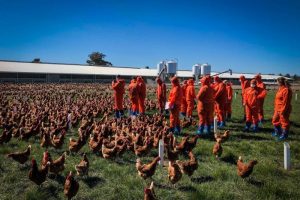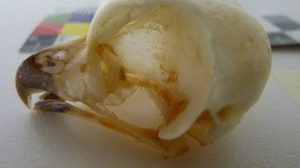Jess Davis of ABC News reports a frozen meringue was key to identifying and outbreak of Salmonella enteritidis (SE), a bacteria that until last year was not found in Australia, that sickened almost 200 people.
 People first started getting sick in May 2018 and by July a cluster of cases had appeared in New South Wales. That was when health authorities started investigating.
People first started getting sick in May 2018 and by July a cluster of cases had appeared in New South Wales. That was when health authorities started investigating.
“Health, through their investigations, were able to look at a number of isolates of Salmonella enteritidis that came from humans, who unfortunately had been ill, and use a technology called whole genome sequencing,” said NSW Food Authority CEO Lisa Szabo.
“So it’s a genetic-based technology that helps us join the dots, shall I say. And this was the first time they could see a group of people with the same whole genome sequence.”
Anyone with a confirmed case of SE was interviewed by investigators and asked for a detailed account of what they’d eaten — to try to find what the different cases had in common.
A few weeks after being interviewed, one of those people remembered they had a frozen meringue cake in their freezer, leftover from a birthday party, around the time they got sick.
Officers went to that person’s home, collected the cake and had it tested.
“We were able to isolate the Salmonella enteritidis and it had that same whole genome sequence. At the same time we could see who manufactured that cake,” Ms Szabo said.
“We could go back to the manufacturer, have a look at their environment, look at how they handle food and where they get their ingredients from, and that’s where we saw the connection to the egg farm.”
 It wasn’t until September that the frozen meringue led investigators to a farm on the outskirts of Sydney, but by then the bacteria had slowly started spreading across the industry.
It wasn’t until September that the frozen meringue led investigators to a farm on the outskirts of Sydney, but by then the bacteria had slowly started spreading across the industry.
“Once we detected salmonella enteritidis on this particular farm, we then commenced another round of investigations … more from the biosecurity and then the farm side of trying to understand … [whether the] farm had other connections to other properties around the state” Ms Szabo said.
But how the bacteria made its way into Australian eggs in the first place is likely to remain a mystery.
One property in Victoria and 13 in NSW have been affected so far and more than half-a-million birds have been culled at a cost of $10 million.
The spread of SE has been blamed largely on the interconnected nature of the egg industry, with all the infected farms connected in some way.
Egg farmers often trade produce with each other, and equipment and workers also regularly move from farm to farm.
Veterinarian Rod Jenner said SE was difficult to contain because it could survive and multiply without a host and could live in the environment for up to two years.
“It can survive in dust and dirt, in vehicles, and can travel in the wind. Rodents, wild birds, that sort of thing, can carry it on their skin or in their bodies as well,” he said.
 “So it has actually been demonstrated to travel vast distances and be contaminated, be deposited on other farms that have previously been free.”
“So it has actually been demonstrated to travel vast distances and be contaminated, be deposited on other farms that have previously been free.”
A farmer’s worst nightmareBede Burke’s egg farm at Tamworth in NSW was the 11th property to be infected, with a notification it had tested positive to SE during a routine check just over three months ago.
“Your whole world crashes down around you, you know,” Mr Burke said.
“We just didn’t sleep for a week and that first seven or eight days was really traumatic. We had to learn how to both decontaminate and disinfect the premises.”
When the notification came through on the eve of the federal election, Mr Burke had to withhold his eggs from sale and was faced with the prospect of culling entire flocks.
“But then you’ve got heap of eggs on your premises, you can’t not stop packing eggs, we were still going to pack 90,000 eggs a day,” he said.
“It’s just stress beyond all belief and then start planning for the worst.”
But he was lucky the contamination was picked up early and while a swab of dirt and dust had tested positive, it hadn’t yet spread to his egg or birds.
There have been no confirmed cases of SE since June and the industry hopes that will be the end of it.
But the outbreak has raised serious questions about how biosecurity is managed. Despite the disease becoming a national problem, its enforcement and regulation is state-based.
Philip Szepe, who runs an egg farm at Kinglake in Victoria, tests for all strains of salmonella every three months.
But he’s concerned that not all farmers are as diligent and said biosecurity was too reliant on self-regulation.
“Government’s really good at responding to crisis. It’d be great if the Government had a bit more engagement with the industry around monitoring, surveillance and compliance,” he said.




 multi-million dollar losses if staff had not discovered poison in the farm’s water stores.
multi-million dollar losses if staff had not discovered poison in the farm’s water stores. its irrigation system was contaminated with herbicide.
its irrigation system was contaminated with herbicide.